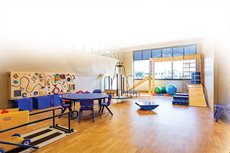Pediatric Rehabilitation
 Pediatric rehabilitation is a medical specialty that focuses on helping children under the age of 18 recover or adapt to congenital and childhood-onset disabilities. It can include physical, occupational and speech therapy depending on a child’s physical and developmental needs. Many children can benefit from pediatric rehabilitation for a variety of medical and developmental conditions and may be referred by their pediatrician to a physical, occupational or speech therapist for evaluation and treatment of their condition.
Pediatric rehabilitation is a medical specialty that focuses on helping children under the age of 18 recover or adapt to congenital and childhood-onset disabilities. It can include physical, occupational and speech therapy depending on a child’s physical and developmental needs. Many children can benefit from pediatric rehabilitation for a variety of medical and developmental conditions and may be referred by their pediatrician to a physical, occupational or speech therapist for evaluation and treatment of their condition.
“Rehabilitation is an important tool in assuring children properly recover from an injury,” said Pediatrician Richard A. Baltisberger, M.D. “LMHS therapists work to decrease pain, improve movement, and prepare children to return to or gain skills needed for daily activities. They teach the young patients exercises designed to regain strength and range of motion, and also demonstrate safe practices to prevent future injuries.”
Pediatric physical therapists focus on improving the ability to move safely and independently by improving gross motor skills, such as rolling, sitting, crawling and walking. They also can utilize techniques to improve strength, balance and coordination allowing children to run, jump, climb stairs, catch and throw balls. Children who undergo surgery for a sports injury use physical therapy to regain strength and mobility.
Splinting is a treatment that is provided to children who have a condition that causes a decreased range of movement in their arms, legs, hands or feet. Using splints can help increase range of motion and mobility as well as improve muscle tone, posture and joint alignment. Infants who suffer from torticollis, a condition that occurs when the baby’s neck becomes twisted, may need a neck brace to help correct the issue. Splints also can be used in children to hold their arm or leg in a stretched position to prevent contractures.
Occupational therapy (OT) helps children to develop motor, sensory and cognitive skills to promote independence in performing everyday tasks. OT can help children with a variety of conditions, such as sensory processing disorders, birth defects, traumatic injuries, learning problems, neurological disorders and autism. Occupational therapists employ techniques that assist with improving a child’s fine motor skills, balance, coordination, and basic life skills, such as bathing, getting dressed and brushing teeth, as well as sensory issues.
Children who have difficulties with speech or language can receive treatment from a speech-language pathologist. A speech disorder refers to a problem with making sounds, such as saying words incorrectly, stuttering, or difficulty with the pitch or volume of the voice. Language disorders are issues with understanding or putting words together to communicate ideas. Children who have problems with feeding disorders, such as chewing and swallowing, coughing, gagging and refusing foods, also can be treated with speech therapy.
Licking Memorial Hospital Rehabilitation Services provides sensory integration rooms for stimulating the senses and a pediatric gym with child-friendly equipment to aid in strengthening, stretching, promoting balance and coordination. There are three private sensory integration rooms with walls that are 12 inches thick, providing minimal distraction for the patient and optimizing the therapy session. The pediatric gym contains a mini jungle gym, a sensory swing and sensory board to assist children with various physical, occupational and speech therapies.
Parents who think their child may be delayed in physical or mental development should discuss their concerns with their pediatrician. All well-child visits should include specific questions about a child’s age-appropriate development. A pediatrician can perform screenings and refer the child to a specialist for a more in-depth evaluation and recommend a treatment plan. It is important to take action early to ensure the best outcome for the child.
| Posted On : 1/14/2022 4:12:22 PM